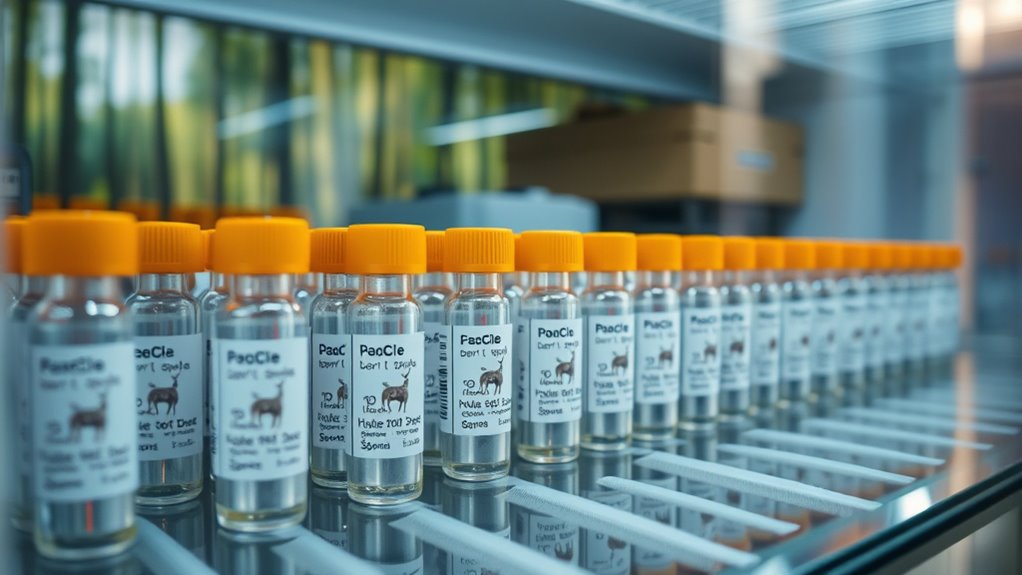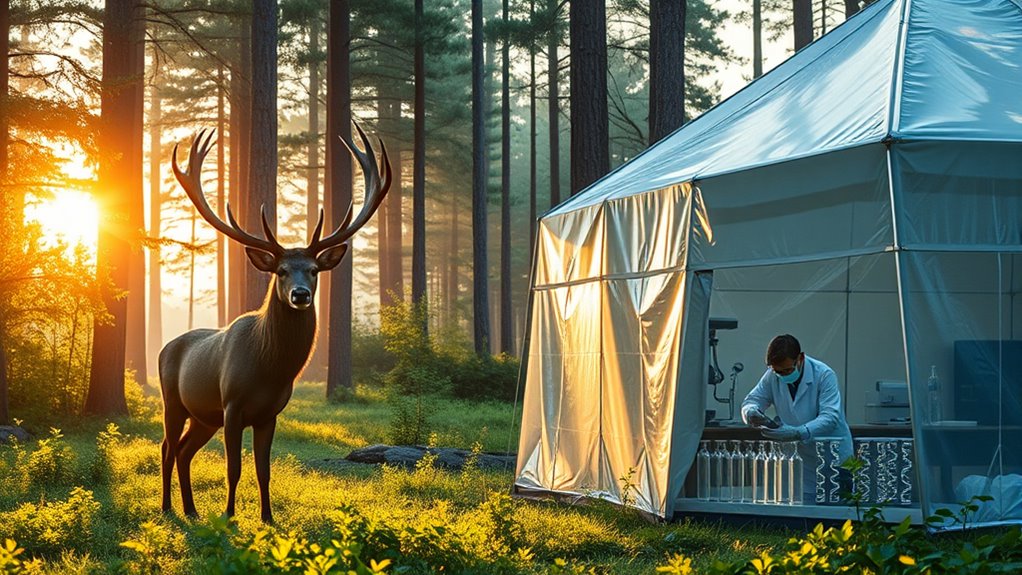The Deer DNA Banking Project safeguards genetic diversity by collecting and preserving genetic material from wild and captive deer populations. This helps guarantee their resilience by maintaining unique genetic traits that protect against diseases and environmental changes. By building a detailed genetic database, the project supports conservation efforts like habitat restoration, population management, and genetic rescue. To discover how these efforts work together to secure deer’s future, you’ll find more insights below.
Key Takeaways
- The project systematically collects diverse DNA samples to represent regional and environmental genetic variation.
- It creates a genetic database to inform conservation strategies and manage populations effectively.
- Preserving genetic material helps prevent inbreeding depression and maintains population resilience.
- The initiative supports genetic rescue efforts to restore or strengthen vulnerable deer populations.
- Public awareness campaigns emphasize the importance of genetic diversity for ecosystem health and species survival.

The Deer DNA Banking Project aims to collect and preserve genetic material from wild and captive deer populations to support conservation efforts. By focusing on genetic preservation, this initiative helps guarantee that the unique genetic makeup of various deer species is maintained for future generations. Preserving genetic diversity is essential because it strengthens the resilience of deer populations against diseases, environmental changes, and habitat loss. Without such efforts, isolated or declining populations risk becoming genetically uniform, which can lead to inbreeding depression and reduce their ability to adapt. Your participation in or support of this project directly contributes to wildlife conservation by creating a genetic repository that acts as a safeguard against extinction.
Through systematic collection of DNA samples, you help build a detailed genetic database representing the diversity across different regions and environments. This database becomes a critical resource for scientists and conservationists who are working to understand genetic variations, disease resistance, and adaptive traits within deer populations. In turn, this knowledge guides effective management strategies, such as habitat restoration, targeted breeding programs, or even genetic rescue efforts. The ability to access high-quality genetic material accelerates research and allows for more precise interventions, which are essential for maintaining healthy, sustainable deer populations.
The project’s emphasis on genetic preservation also supports broader wildlife conservation goals. By maintaining a genetic library, you help safeguard the evolutionary legacy of deer species, many of which face threats from habitat destruction, poaching, and climate change. This genetic resource acts as an insurance policy, offering the potential to restore or bolster populations that have been severely impacted. It also provides a way to reintroduce genetic diversity into small or fragmented populations, increasing their survival chances over the long term. Your involvement ensures that these efforts are scientifically grounded and sustainable, making a real difference in the fight to conserve wildlife.
Furthermore, the project promotes public awareness about the importance of genetic diversity in wildlife conservation. As you learn more about how genetic preservation supports healthy ecosystems, you’re encouraged to advocate for policies that prioritize biodiversity. This initiative underscores that conservation isn’t just about protecting individual animals but about maintaining the genetic fabric that underpins entire species. By safeguarding genetic diversity, the Deer DNA Banking Project helps secure the future of deer populations around the world, offering hope for their survival amid ongoing environmental challenges. Your support, whether through awareness, funding, or participation, plays an indispensable role in ensuring these efforts continue and expand.
Additionally, understanding the importance of genetic diversity emphasizes the need for genetic preservation, which is fundamental to maintaining resilient and adaptable populations over time.
Frequently Asked Questions
How Is DNA Collected Ethically From Wild Deer Populations?
When collecting DNA from wild deer, you focus on ethical considerations by using non-invasive sampling techniques, like collecting hair or feces, which minimize stress and harm. You guarantee proper permits are obtained and avoid disrupting natural behaviors or habitats. By adhering to these guidelines, you respect the animals’ welfare and ecological integrity, making sure your sampling methods are responsible and sustainable while gathering the necessary genetic information ethically.
What Types of Genetic Information Are Stored in the Bank?
You store various genetic information in the bank, focusing on genetic markers that identify individual deer and track inherited traits. These markers help you measure diversity metrics, which assess the overall genetic variation within populations. By analyzing this data, you can monitor genetic health, guarantee adaptive potential, and make informed conservation decisions. This thorough genetic information safeguards the species’ resilience and longevity, supporting effective management and preservation efforts.
How Is Data Privacy Maintained for Genetic Samples?
Ever wondered how your genetic data stays private? You’re protected through data encryption, which secures your samples from unauthorized access. Access control measures ensure only authorized personnel can view or handle your genetic information. These safeguards prevent misuse and keep your privacy intact. So, you can trust that your genetic samples are stored securely, with robust protections in place, giving you peace of mind about your personal data.
Can the Project Assist in Deer Population Recovery Efforts?
You can see that the project critically aids deer population restoration by preserving genetic diversity. By collecting and storing genetic samples, it helps identify healthy, diverse genes essential for resilience. This genetic information guides conservation efforts, ensuring that reintroduction or population growth strategies maintain diversity. In this way, the project plays a key role in supporting long-term deer population recovery and ecological balance.
What Are the Long-Term Funding Plans for the DNA Bank?
You wonder about the long-term funding plans for the DNA bank. To guarantee funding sustainability, the project relies on diverse donation strategies, including government grants, private donations, and partnerships. These strategies work together to create a stable financial foundation, securing ongoing support. By continuously engaging with donors and exploring new funding avenues, you can help maintain the bank’s essential work in preserving genetic diversity for future generations.
Conclusion
By participating in the Deer DNA Banking Project, you become a crucial guardian of nature’s most precious treasure—genetic diversity. Your efforts help guarantee that future generations can marvel at thriving deer populations, even in the face of challenges that threaten to wipe out entire species. Think of this project as a shield as powerful as a fortress, protecting the intricate tapestry of life. Together, you’re making history—preserving the wild’s incredible legacy for eternity.










